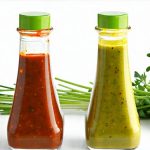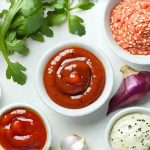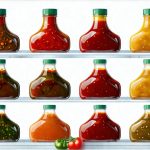Many of us enhance our meals with condiments and sauces – they add flavor, texture, and can transform a simple dish into something truly enjoyable. However, for a significant portion of the population, this seemingly harmless addition often comes at a price: digestive discomfort. Bloating, gas, heartburn, even diarrhea are common complaints linked to these culinary staples. It’s not necessarily about eliminating condiments entirely; it’s about understanding why they cause issues and learning how to navigate them effectively so you can enjoy your food without the aftermath. This article delves into the factors that make certain condiments problematic for digestion, and offers practical strategies for minimizing or avoiding those unwanted effects.
The digestive system is a complex ecosystem, and its sensitivity varies greatly from person to person. What one individual tolerates with ease might cause significant distress in another. Condiments frequently contain ingredients that can trigger these sensitivities – high levels of acidity, specific sugars, artificial additives, or even seemingly benign spices. Furthermore, the way we combine condiments with other foods can also play a role. Understanding your own body’s response to different flavors and textures is crucial, as is recognizing common culprits and adopting mindful eating habits. This isn’t about restrictive diets; it’s about informed choices that prioritize digestive wellbeing. If you frequently experience discomfort after meals, consider exploring how digestive tests help explain low appetite and early satiety to gain deeper insights into your digestion.
Identifying Common Culprits in Condiments & Sauces
The world of condiments is vast, but certain ingredients consistently contribute to digestive issues for many people. High-fructose corn syrup (HFCS) is a prime example. Found in ketchup, barbecue sauce, and numerous sweet sauces, HFCS can be poorly absorbed by some individuals, leading to bloating, gas, and diarrhea. Similarly, excessive amounts of sugar, even from natural sources like honey or maple syrup used in dressings, can disrupt gut bacteria balance and cause discomfort. Acidity is another major factor; vinegar-based condiments like mayonnaise, relish, and certain salad dressings can exacerbate heartburn or acid reflux in sensitive individuals.
Beyond sugars and acidity, consider the role of additives. Emulsifiers, preservatives, and artificial flavors – prevalent in mass-produced sauces – are often difficult for the gut to process and have been linked to inflammation and digestive upset. Even seemingly healthy condiments like soy sauce can be problematic due to their sodium content, which can contribute to bloating and fluid retention. Furthermore, ingredients like garlic and onions, while flavorful, contain fructans, a type of FODMAP (Fermentable Oligosaccharides, Disaccharides, Monosaccharides And Polyols) that can trigger symptoms in individuals with Irritable Bowel Syndrome (IBS) or similar sensitivities. Understanding foods that cause gas and how to avoid them can also help pinpoint triggers.
Finally, the fat content of certain sauces – think creamy dips, rich salad dressings, and some pesto varieties – can slow down digestion and contribute to feelings of fullness or even nausea if consumed in large quantities. It’s important to remember that these are general tendencies; individual tolerance levels will vary significantly. Paying attention to how your body reacts to specific ingredients is the first step toward identifying potential triggers. Avoiding digestive overload at dinner can also contribute to better digestion overall.
Navigating Spicy Condiments & Sauces
Spicy condiments, like hot sauce, chili paste, and Sriracha, can be a digestive minefield for some. Capsaicin, the active compound responsible for the heat in chilies, isn’t directly irritating to the gut lining but it can stimulate increased stomach acid production. For people prone to heartburn or GERD (Gastroesophageal Reflux Disease), this can lead to uncomfortable symptoms. Additionally, rapid transit through the digestive system – often a consequence of consuming spicy foods – doesn’t allow adequate time for proper digestion and absorption, potentially causing diarrhea or cramping.
Here’s how to mitigate these effects:
1. Start with small amounts: Gradually increase your tolerance by adding just a dab of hot sauce initially.
2. Pair with other foods: Consuming spicy condiments with a meal – rather than on their own – helps buffer the acidity and slow down digestion. Foods rich in healthy fats can be particularly helpful.
3. Choose milder options: Explore varieties with lower Scoville Heat Units (SHU) or opt for sauces based on different chili peppers, as capsaicin levels vary significantly between types.
4. Hydrate well: Drinking water alongside spicy foods helps dilute stomach acid and aids in digestion.
It’s also worth noting that some individuals find relief by avoiding nightshade vegetables entirely (chilies are part of this family), suspecting a sensitivity beyond just the capsaicin content. Listening to your body is paramount. If you struggle with digestive issues during travel, adjust your diet during travel to avoid discomfort.
Understanding FODMAPs & Condiment Choices
FODMAPs, as mentioned earlier, are short-chain carbohydrates that can be poorly absorbed in the small intestine, leading to fermentation by gut bacteria and subsequent digestive symptoms. Many common condiments contain high levels of these compounds. Onion and garlic – frequently used in dips, sauces, and dressings – are significant FODMAP sources. Similarly, honey, applesauce (often found in barbecue sauce), and even some tomato-based products can contribute to FODMAP overload.
For individuals with IBS or FODMAP sensitivities, careful condiment selection is essential. Look for low-FODMAP alternatives:
* Garlic-infused oil instead of fresh garlic: The flavor remains while the problematic fructans are removed.
* Onion and garlic substitutes like asafoetida (hing) in small amounts can mimic the flavor without triggering symptoms.
* Choose condiments made with minimal ingredients and avoid those containing HFCS or excessive sugar.
* Opt for vinegar-based dressings over creamy ones, as creaminess often indicates higher lactose content which is a FODMAP.
There are growing numbers of specifically low-FODMAP condiment options available commercially, making it easier to enjoy flavor without compromising digestive health. Sometimes digestive trouble from trying to be ‘too clean’ can also impact your gut microbiome and sensitivity to FODMAPs.
Reading Labels & Making Informed Choices
The most powerful tool in avoiding digestive discomfort from condiments and sauces is informed purchasing. This begins with meticulously reading ingredient labels. Don’t just look at the front of the package; scrutinize the full list. Pay attention to hidden sugars (dextrose, maltose, sucrose), artificial sweeteners, additives like xanthan gum or carrageenan, and excessive sodium content.
Here are some practical tips for label reading:
1. Prioritize condiments with short ingredient lists: Fewer ingredients generally mean less potential for problematic substances.
2. Look for natural alternatives: Choose options sweetened with natural sugars in moderation, or opt for unsweetened versions whenever possible.
3. Be wary of vague terms: “Natural flavors” can encompass a wide range of additives; if you’re sensitive, look for more specific ingredient lists.
4. Consider making your own condiments: This allows complete control over ingredients and ensures that nothing problematic is included. Homemade dressings, sauces, and dips are often surprisingly easy to prepare.
Ultimately, building a relationship with your digestive system involves understanding its unique sensitivities and making conscious choices based on that knowledge. Don’t be afraid to experiment with different brands, recipes, and combinations until you find what works best for you. Planning ahead can also help; avoid bloating on special occasions and holidays by preparing your own condiments or bringing safe alternatives to gatherings.


















